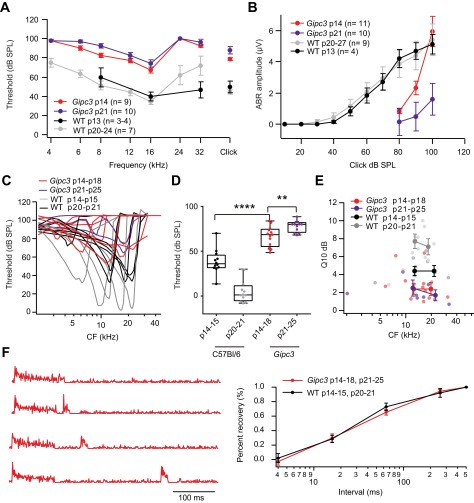Fig. S6.
Auditory population responses, single unit tuning curves, and assessing recovery from adaptation using a forward masking paradigm in Gipc3 mutant mice. (A) ABR thresholds for tone burst stimuli and click were elevated in both p14 and p21 Gipc3 mutant mice compared with WT (C57BL/6). (B) Average ABR wave I amplitude as a function of click sound pressure level. At p14, higher click levels were needed to evoke a reproducible ABR wave I, but the amplitude of this wave can grow very steeply to a value that was comparable to WT controls. However, at p21, the wave I amplitude of Gipc3 mutant mice did not reach the level at p14 and of control. (C) Representative tuning curves of Gipc3 mutant SGNs. (D) Gipc3 mutant SGNs had elevated thresholds at the characteristic frequency in comparison with WT SGNs at comparable ages (66.6 ± 3.1, n =13 for Gipc3 mutant p14–18 vs. 38.5 ± 3.9, n = 12 for WT p14–15, P < 0.00001; 77.8 ± 1.8, n = 12 for Gipc3 mutant p21–25 vs. 5.4 ± 3.7, n = 12 for WT p20–21, P < 0.0001). (E) Sharpness of tuning was significantly broader in Gipc3 mutant SGNs (2.7 ± 0.5, n = 12 for Gipc3 mutant p14–18 vs. 4.3 ± 0.4, n = 12 for WT p14–15, P < 0.05; 2.1 ± 0.5, n = 7 for Gipc3 mutant p21–25 vs. 7.1 ± 0.6, n = 12 for WT p20–21, P < 0.0001). (F) Assessing recovery from adaptation using forward masking paradigm. (Left) Representative responses of a Gipc3 mutant SGN to the experimental paradigm that consisted of a 100-ms-long masker stimulus and a 15-ms probe tone (both tone bursts at the characteristic frequency, 30 dB above threshold). (Right) The time course of recovery was derived by normalizing the response to 15-ms probe stimulus to the last 15 ms (0% recovery) and first 15 ms of masker response (100% recovery). Gipc3 mutant SGNs (n = 9) showed a recovery time course similar to that of WT SGNs (n = 8).

